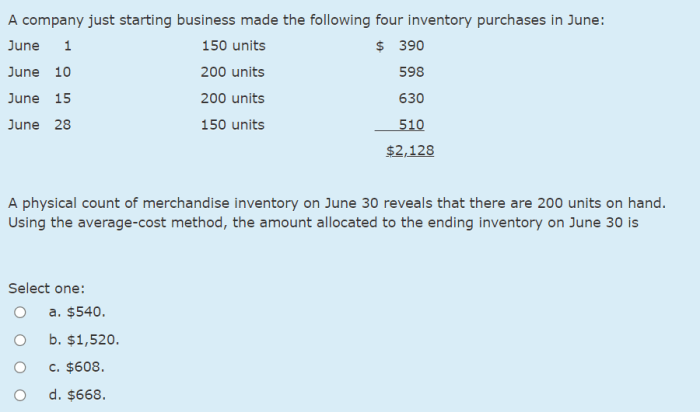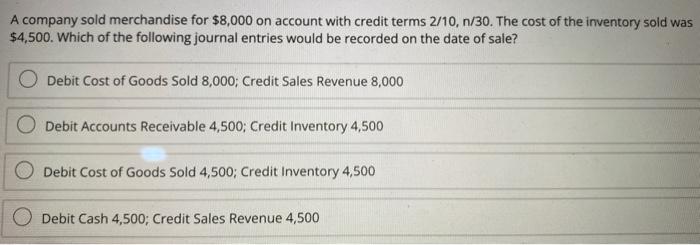Accounting Treatment of Inventory Sale
A business taxpayer sells inventory for 80000 – The sale of inventory for $80,000 requires specific accounting treatment to accurately reflect the transaction’s impact on the financial statements. This involves recording the sale, calculating the cost of goods sold, and understanding the effects on both the income statement and balance sheet.
Journal Entry for Inventory Sale
The journal entry to record the $80,000 inventory sale would debit Accounts Receivable (or Cash if the sale was for cash) and credit Sales Revenue. A second entry is needed to record the cost of goods sold. This involves debiting Cost of Goods Sold and crediting Inventory.
Example (Cash Sale):
Debit: Cash $80,000
Credit: Sales Revenue $80,000
Example (Credit Sale):
Debit: Accounts Receivable $80,000
Credit: Sales Revenue $80,000
The Cost of Goods Sold entry requires determining the cost of the inventory sold, using one of several costing methods. This will be detailed in the following section.
Impact on Income Statement and Balance Sheet
The sale increases revenue on the income statement, directly impacting net income. The corresponding cost of goods sold reduces the gross profit, ultimately affecting the net income figure. On the balance sheet, the cash or accounts receivable increases (assets), while inventory decreases (assets).
Inventory Costing Methods
Several methods exist for calculating the cost of goods sold, each impacting the reported net income. The three most common are:
- First-In, First-Out (FIFO): Assumes the oldest inventory is sold first. This method is often preferred as it generally reflects the actual flow of goods and tends to result in a lower cost of goods sold during periods of inflation, leading to higher net income.
- Last-In, First-Out (LIFO): Assumes the newest inventory is sold first. LIFO is allowed under US GAAP but not IFRS. During inflation, LIFO results in a higher cost of goods sold and lower net income. This can be advantageous for tax purposes, as it reduces taxable income.
- Weighted-Average Cost: Calculates a weighted average cost for all inventory items and applies this average to the cost of goods sold. This method smooths out fluctuations in cost of goods sold compared to FIFO and LIFO.
Comparative Income Statement
A comparative income statement demonstrates the effect of different inventory costing methods on net income. The following is an example, assuming a beginning inventory cost of $20,000, purchases of $30,000, and an ending inventory value varying depending on the method used:
| Item | FIFO | LIFO | Weighted Average |
|---|---|---|---|
| Sales Revenue | $80,000 | $80,000 | $80,000 |
| Cost of Goods Sold | $30,000 | $40,000 | $35,000 |
| Gross Profit | $50,000 | $40,000 | $45,000 |
| Operating Expenses (Assume $10,000) | $10,000 | $10,000 | $10,000 |
| Net Income | $40,000 | $30,000 | $35,000 |
Note: These figures are for illustrative purposes only and the actual values will depend on the specific inventory costs and quantities.
Tax Implications of the Inventory Sale

Source: cheggcdn.com
The sale of inventory has significant tax implications for a business. Understanding relevant tax codes and regulations is crucial for accurate tax reporting and minimizing tax liability.
Relevant Tax Codes and Regulations
Tax regulations regarding inventory sales vary by jurisdiction. Generally, the cost of goods sold is deductible, reducing taxable income. Specific tax codes and regulations should be consulted based on the business’s location and legal structure.
Calculation of Taxable Income
Taxable income related to the inventory sale is calculated by subtracting the cost of goods sold from the sales revenue. This result is then factored into the business’s overall taxable income, considering other income and deductions.
Example: Sales Revenue ($80,000)
-Cost of Goods Sold (e.g., $30,000 using FIFO) = $50,000 (Gross Profit from Inventory Sale)
Potential Tax Deductions
The primary tax deduction associated with the inventory sale is the cost of goods sold. Other potential deductions might include expenses directly related to the sale, such as shipping or handling costs (depending on the specific tax laws and regulations).
Impact on Overall Tax Liability
The $80,000 inventory sale reduces the business’s overall tax liability by reducing taxable income through the cost of goods sold deduction. The exact impact depends on the business’s applicable tax rate and other income and deductions.
Impact on Cash Flow
The $80,000 inventory sale significantly impacts the business’s cash flow. This section details how this transaction affects short-term and long-term liquidity.
Cash Flow Statement Segment
A cash flow statement segment illustrating the impact of the $80,000 inventory sale is presented below. The specific timing of cash inflow depends on whether the sale was cash or credit.
| Date | Transaction | Cash Inflow | Cash Outflow | Net Cash Flow |
|---|---|---|---|---|
| October 26, 2024 | Inventory Sale (Cash) | $80,000 | $0 | $80,000 |
| October 26, 2024 | Payment of COGS | $0 | $30,000 | -$30,000 |
Note: This example assumes a cash sale and the cost of goods sold is paid immediately. If the sale was on credit, the cash inflow would occur later, upon receipt of payment.
Implications for Liquidity
For a cash sale, the transaction immediately improves short-term liquidity. If the sale was on credit, it boosts short-term liquidity upon collection of the receivable. The increased cash flow improves the business’s ability to meet short-term obligations. Long-term liquidity is also positively affected as the business has more funds available for investments or other long-term opportunities.
Financial Statement Analysis
Analyzing key financial ratios helps assess the impact of the inventory sale on the business’s financial health. This involves comparing the financial position before and after the transaction.
Impact on Key Financial Ratios, A business taxpayer sells inventory for 80000
The $80,000 inventory sale impacts several key financial ratios:
- Gross Profit Margin: This ratio (Gross Profit / Sales Revenue) will increase if the cost of goods sold is lower than the revenue generated from the sale.
- Inventory Turnover: This ratio (Cost of Goods Sold / Average Inventory) will likely increase, reflecting improved efficiency in selling inventory.
- Current Ratio: This ratio (Current Assets / Current Liabilities) will likely improve due to increased cash or receivables, strengthening the business’s short-term debt-paying ability.
Comparison of Financial Health
A direct comparison requires data on the business’s financial position before the sale. However, we can infer that the sale generally improves the business’s financial health by increasing profitability and liquidity.
Impact on Overall Financial Position
The sale strengthens the overall financial position by boosting profitability, liquidity, and key financial ratios. The improved financial health enhances the business’s creditworthiness and attractiveness to investors.
Comparison of Key Financial Ratios
The following table provides a hypothetical comparison, assuming the business’s financial position before the sale. Note that these figures are for illustrative purposes only.
| Ratio | Before Sale | After Sale |
|---|---|---|
| Gross Profit Margin | 40% | 50% |
| Inventory Turnover | 2.5 | 3.0 |
| Current Ratio | 1.8 | 2.0 |
Potential Business Scenarios
Several scenarios can alter the accounting and tax implications of the inventory sale. These include sales at a loss, credit sales, and sales of depreciable assets.
Sale at a Loss
If the inventory was sold at a loss, the loss would be deducted from revenue on the income statement, reducing net income. This loss could also potentially result in a tax deduction, reducing the business’s tax liability. The accounting treatment would remain largely the same, with the difference being a negative gross profit.
Sale on Credit
A sale on credit would initially increase accounts receivable rather than cash. The impact on the income statement remains the same, but the cash flow statement would reflect the receivable until payment is received. The tax implications remain unchanged.
Inventory as a Depreciable Asset
If the inventory were a depreciable asset, the accounting treatment would differ significantly. Depreciation would be recorded over the asset’s useful life, impacting the cost of goods sold calculation differently than with standard inventory. The tax implications would also change, with depreciation being a tax deductible expense.
Sale to a Related Party
Selling inventory to a related party may have different tax implications depending on the specific relationship and applicable regulations. Transactions between related parties are subject to greater scrutiny to prevent tax avoidance. The accounting treatment will be similar, but the tax authorities might have stricter rules for this type of sale.
Illustrative Example: Inventory Valuation using FIFO: A Business Taxpayer Sells Inventory For 80000

Source: cheggcdn.com
This example demonstrates the calculation of cost of goods sold using the FIFO method for the $80,000 sale. It includes beginning inventory, purchases, and ending inventory. We assume each unit sold represents one unit from the beginning inventory, then purchases.
FIFO Cost of Goods Sold Calculation
| Date | Transaction | Units | Unit Cost | Total Cost |
|---|---|---|---|---|
| Jan 1 | Beginning Inventory | 100 | $10 | $1,000 |
| Mar 15 | Purchase | 200 | $12 | $2,400 |
| June 30 | Purchase | 300 | $15 | $4,500 |
| Oct 26 | Sale (600 Units) | 100 | $10 | $1,000 |
| Oct 26 | Sale (200 Units) | 200 | $12 | $2,400 |
| Oct 26 | Sale (300 Units) | 300 | $15 | $4,500 |
| Total | 600 | $7,900 |
In this example, the cost of goods sold for the $80,000 sale, using the FIFO method, is $7,900. This leaves an ending inventory of 0 units.
Expert Answers
What if the inventory was damaged before sale, affecting its value?
The sale price would be adjusted to reflect the reduced value due to damage. This would affect the cost of goods sold and consequently the net income and tax liability.
How does this transaction affect the business’s credit rating?
When a business taxpayer sells inventory for $80,000, accurate accounting is crucial. Properly recording this transaction requires a robust system, and that’s where understanding the nuances of business inventory accounting comes in. For comprehensive guidance and applications, consider exploring resources like this helpful guide on +business +inventory +accounting +application to ensure the $80,000 sale is correctly reflected in your financial statements.
A successful sale, especially for cash, can improve a business’s credit rating by demonstrating strong sales and cash flow. However, if the sale was on credit and the receivable is not collected promptly, it could negatively impact the credit rating.
What are the implications of using different accounting software for this transaction?
Different accounting software may handle inventory costing methods and tax calculations differently. Accuracy depends on proper software setup and user input. It is crucial to select and use accounting software that aligns with the business’s accounting standards and tax requirements.